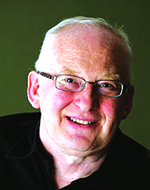Page Content
Focused on equity in mathematics, the NORCAN partnership has sent Canadian teachers to observe teaching practices in math classrooms at Molde Upper Secondary School in Molde, Norway.
—Photo by John Scammell
The next best questions for Alberta Education
 When organizations are facing the prospect of embracing bold innovations they need to take a hard look at themselves by asking four questions:
When organizations are facing the prospect of embracing bold innovations they need to take a hard look at themselves by asking four questions:
(a) What do we need to stop doing — what is getting in the way of the work?
(b) What do we do well but need to improve so we can do it better?
(c) What do we need to be doing but do badly right now and need to get much better at?
(d) What don’t we do at all but better start doing if we want to make a difference and stay in the game?
In my consulting work both here in Canada and abroad, I have used these questions in hundreds of organizations from large global banks and some of the world’s biggest retailers and manufacturing organizations to some of the biggest nonprofits. I also found these questions to be very helpful over the past five years as I have provided strategic advice to the Alberta Teachers’ Association and its international partner schools in Finland and Norway. These same questions also offer timely insight for Alberta Education and Minister David Eggen as Albertans continue to wait to see concrete action on much needed reform.
There are three things they need to stop doing so that the school system in Alberta can significantly improve.
The first is reasonably obvious and was recognized as such by at least one of our many recent premiers: stop provincial achievement testing and the use of the Programme for International Student Assessment (PISA) and Trends in International Mathematics and Science Study (TIMMS) and similar international benchmarking. Albertans need to own the metrics they determine as the indicators of what they truly value. Finland does not test students until they are leaving high school, and several countries are looking critically at the costs and value of the PISA snapshot and asking if it’s worth it, especially given the impossibility of translating the ways of one high-performing system, like Singapore, into a different culture with different structures and processes.
As a colleague and critical friend of Alberta has often suggested, we have known for a considerable time that standardized achievement measures are essentially measures of social status and that teachers have little influence on the scores students achieve on these standardized tests (Berliner 2014). What standardized tests largely measure is poverty and socio-economic and cultural status with respect to performance on a specific test item. The pretense that these data show the impact teachers or schools have on performance remains a remarkable but puzzling reality. More so, there is compelling evidence that some school systems are “gaming” PISA and TIMMS by driving curriculum and instruction so that they can secure strong national results. One need only look to our current ministry’s almost singular focus on literacy and numeracy — distracting us from the more important work of advancing an interdisciplinary curriculum and a sophisticated approach to public assurance.

Alberta’s Grade 3 Student Learning Assessment program was intended to help teachers better understand the learning needs of their students in their care but have instead drawn criticism for imposing unnecessary work and activity on a system that’s already under pressure. —Stock
For example, there are strong processes for students in Finland who are not seeking university entrance, but instead are looking to the trades and semi-professional skills. They are constantly given workplace assignments, practical projects and competency-based assessments so that they and those teaching and working with them can track progress. In Norway and Finland, progress tracking is a teacher professional responsibility, not that of the bureaucracy.
This also means stopping the Grade 3 Student Learning Assessments (SLA) initiative which has relapsed into a rebooted digital version of the decades-old provincial achievement testing program. These SLAs have morphed from a promise to provide rich performance tasks to become a new tax of Grade 3 teachers’ emotional energy that consumes two days of school work at the beginning of the year. They are mostly nonsense — irrelevant noise that does not help students, teachers or the system. Why the ministry is persisting with these, even on a smaller (but still compulsory) scale tells us a lot about the groupthink within the department.
The Grade 3 SLAs were intended to help teachers better understand the learning needs of the students in their care — as if external testing with results some weeks later would help this work. Instead, they have become a test of the ministry’s power and authority to impose unnecessary work and activity on a system already under pressure. Stop now and gain credibility or persist and continue to lose it. Trust teacher assessment of the students they teach every day. If “system reporting” is required, let Grade 3 teachers design such a system for their districts.
Second, the ministry of education needs to rethink its collaboration and relationship strategy. Stop being “command and controller” and start being facilitator, shaper and engager. Rather than issuing directives, approving the appointment of superintendents, and determining curriculum at a level of fine detail, it should be offering guidance and support and encouraging school systems to be more directly able to determine how teaching and learning should occur, how inclusion is best achieved and lead a process of curriculum change rather than direct it. This is how it’s done in some other parts of the world (Finland and Queensland, for example).
As part of this new approach, the ministry should be establishing, along with its educational partners, the broad outlines of what students should be able to achieve at key stages in the school system (Grades 3, 7, 9 and 11): learning outcomes for students at various stages are needed to guide the system. But what specifically is taught, when and how is a matter for the profession to determine. The specialist councils of the Alberta Teachers’ Association should have a role in taking agreed key-stage frameworks and then fleshing out what needs to happen in mathematics, social studies, science, arts and other subject areas.
Curriculum is not just about what the student learns but how, and these are the core competencies of professional teachers. To truly maintain Alberta’s leadership in education in the English-speaking world, we need less curriculum definition from government and more curriculum development from teachers and the profession. Finland’s ministry, working with teacher professional bodies, offers a framework for the curriculum, leaving the profession to define the specifics of the curriculum. The aim of all parties, based on trust, is to leverage the distinctive expertise of professional teachers.
A role government could play in this less-is-more scenario is to develop, with the profession, a set of critical pathways for success for different kinds of learners at the key stages of their development. The ministry might want to take a look at what Alberta Health is doing with its Strategic Clinical Networks (SCN) in defining such pathways for health care. Using collaborative networks of practitioners coupled with research and expert patients, each SCN is developing best practice care pathways for specific illnesses so that all caregivers know what produces the best outcomes. General practitioners and specialists are not obliged to follow these pathways, because each patient is different, but they know to track outcomes so they can provide a rationale for not following effective practice.
Teachers could do the same. What they need is investment and support for turning the “clinical” research into effective teaching practices for teaching and learning in each subject area, especially focusing on interdisciplinary learning and equity — a kind of Alberta Action Research Network (AARN). This action-focused research approach reflects the approaches we have seen in Ontario, Norway, Finland, Singapore, New Zealand and parts of Australia. The Alberta Teachers’ Association and a number of education experts have created a national mechanism for sharing — The Canadian Journal for Teacher Research (http://www.teacherresearch.ca/home/), a web-enabled multimedia journal.
By dialing down its preoccupation with overspecifying curriculum but supporting AARN, the ministry could then provide real support to teachers’ professional learning and enable a great deal of curriculum innovation and new activity. The rule of less is more, as we have seen in jurisdictions such as Finland and Singapore, should become the new mantra for Alberta Education. This might enable the size of the ministry to fall from its current range of 650 to 700 people to be nearer 100, the size of Finland’s ministry of education.
The final issue that Alberta really needs to address is inclusion. Wherever you travel in Alberta and talk with superintendents, teachers and students, inclusion is an issue. Alberta has the right intentions, but not the right policy, practice or funding. Some of my English colleagues would argue that the issue is the idea of inclusion itself — it may not be the solution for every child with special needs in every circumstance. As one Alberta special needs educator has rightly asked “is being included into a bad situation what the advocates of inclusion really want?” The ministry needs to stop pretending that it has all the answers and start to rethink both funding and support for inclusion. A high-level ministerial summit on inclusion, in which the focus is on strategy and practice, followed by a shift of responsibility from the ministry to districts so that school authorities can find their own solutions may provide more insights into what is possible than all jurisdictions trying to march to the same drumbeat determined by the ministry.
This latter point reflects a different view of leadership across Alberta’s education system, something now being looked at by all educational partners. What is taking place is a shift from a hierarchical view of school systems to a view that gives greater emphasis to networks, pipelines and flatter, more collaborative and collective organizations (Van Alstyne et. al 2016). Leadership is changing and this needs to be reflected in the way leaders are chosen, engaged and supported.
Every time an organization explores the four questions posed at the beginning of this article — stop, improve, redesign, start — they find more things to start, improve and redesign than to stop. Stopping is hard. Yet, we know that doing the same thing and expecting different results is a nonstarter. So, to improve, we need to stop doing those things that are getting in the way. Each part of our education system would show real leadership by doing less and doing a better job of those things that we need to do.
References
Berliner, D. C., G. V. Glass and associates. 2014. 50 Myths and Lies That Threaten America’s Public Schools —The Real Crisis in Education. New York, NY: Teachers College Press.
Van Alstyne, M. W., G. G. Parker and S. P. Choudray. 2016. “Pipelines, Platforms and Networks —The New Rules of Strategy.” Harvard Business Review, April.
Stephen Murgatroyd is chief executive of Collaborative Media Group Inc.
